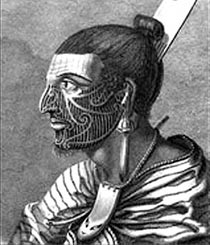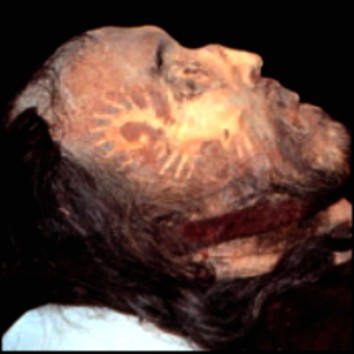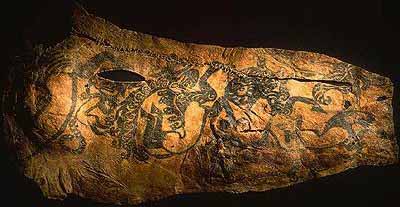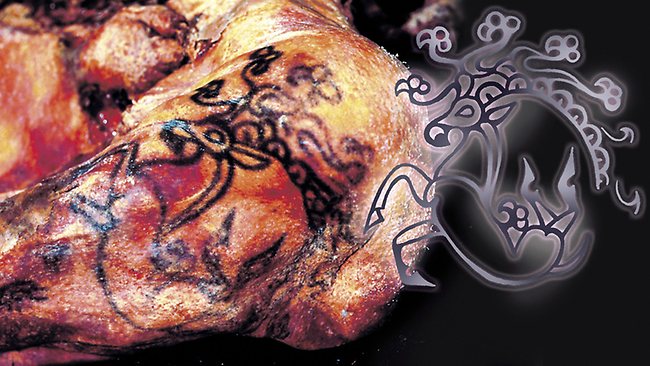|

 Tattoo's: (Body Art)
Tattoo's: (Body Art)
The word Tattoo 'Tatau'
originates from Polynesia. It was first written in the records from
Captain Cooks Voyages in 1769.
We have found
enough tattooed remains now to realise that tattooing is an ancient
and widespread art. Some of the earliest examples of tattooing comes
from Japan, and are found in the form of clay figurines that have
faces painted or engraved to represent tattoo marks. The oldest
figures of this kind have been recovered from tombs dated to 5,000
BC or older.(6)
Some bodies appear
to show a correlation between the locations of their tattoos and
modern day recognised acupuncture points. The Ice-man 'Otzi' was
found to have illnesses related to his 'acupuncture' - Tattoo marks.
They are cautiously presumed to be therapeutic.
(Prehistoric
Tattooing and Acupuncture)
|
The
History of Tattooing: |
Article: Dec, 2012 (PopularArchaeology)
'...Skin
Decoration Goes Well Back Suggests Researcher...'
'Over thousands
of years, humans used their skin as canvases of self-expression
in a variety ways, including permanent methods such as tattooing
and branding, as well as temporary, including cosmetics and body
painting, according to Jablonski. But the determination of when
this practice began to occur is difficult because it can be
preserved only for a few thousand years. Nevertheless, while it
is difficult to know when humans began to decorate their skin,
some of the earliest preserved skin shows signs of tattooing,
maintains Jablonski.
A recent
discovery of a prehistoric "workshop" in the South African cave
of Blombos, for example, evidenced the manufacture of ochre in a
cave where there was no evidence of any wall painting. The
"workshop", consisting of abalone shells where ochre was stored
and processed, combined with fat, crushed bone, quartz and
charcoal to produce a pigment compound that was possibly used as
paint for painting, decoration and skin protection, was dated to
about 100,000 years BP. The dating corresponds to a time when
early modern humans were thought to be on the threshold of
thinking and expressing themselves in symbolic ways and laying
the foundations for art and language'.
(Link
to Full Article)
Egyptian
Tattoo's
There's plenty
of evidence that women had
tattoos on their bodies and limbs from figurines
c. 4000-3500 B.C. to occasional female figures
represented in tomb scenes c. 1200 B.C. and in
figurine form c. 1300 B.C., all with tattoos on
their thighs. Also small bronze implements
identified as tattooing tools were discovered at
the town site of Gurob in northern Egypt and
dated to c. 1450 B.C. And then, of course, there
are the mummies with tattoos, from the three
women already mentioned and dated to c. 2000
B.C. to several later examples of female mummies
with these forms of permanent marks found in
Greco-Roman burials at Akhmim.
(2)
Historical records and Hieroglyphs revealed that the
many bodies from the 11 Dynasty in Egypt and then
onwards indulged in the art of tattooing. Basic ancient
Egyptian tattooing followed the median lines and the
human body was garnished with simple dots and lines that
depicted the flow of energy in human beings and the
different gods and goddesses.
Written records for the mummy of Amunet who was a
priestess to the goddess Hathor whose body was found at
Thebes, revealed that there were many dots and lines
tattooed across her body. The different dots and lines
follow the flow of blood throughout the body and aimed at
aligning the human life force with the celestial flow of energy
in the universe. Ancient cultures utilized heavy symbolism to
speak or create art. In fact circles, dots, lines and geometric
patterns, we utilized to communicate or represent different
aspects of culture and religion.
(1)
The purposes of
prehistoric tattoos among the ancient Egyptians is currently a
point of contention among many historians. Some researchers
believe that tattoos were used to mark prostitutes. Others think
that the spread of designs over the abdomen on female mummies
points to tattoos having played a more therapeutic role during
pregnancy. A dwarf god named Bes is tattooed on the upper thighs
of many female mummies. The presence of Bes may have been
intended to further protect women as they gave birth, although
we can�t be sure of the meanings of prehistoric tattoos.
(4)
(Ancient
Egypt Homepage)
European Tattoo's:
 The
oldest mummy so far discovered with prehistoric tattoos, dates back
to the 3300 B.C. Named 'Otzi the Iceman', his body was extensively
covered with therapeutic tattoos made from soot. In total, his body bore 57
tattoos, in different parts - a cross on the inside of the left
knee, six straight lines 15 centimetres long above the kidneys and
numerous small parallel lines along the lumbar, legs and the ankles.
(3) The
oldest mummy so far discovered with prehistoric tattoos, dates back
to the 3300 B.C. Named 'Otzi the Iceman', his body was extensively
covered with therapeutic tattoos made from soot. In total, his body bore 57
tattoos, in different parts - a cross on the inside of the left
knee, six straight lines 15 centimetres long above the kidneys and
numerous small parallel lines along the lumbar, legs and the ankles.
(3)
It
has been speculated that these tattoos may have been related
to pain relief treatments similar to acupressure or
acupuncture. If so, this is at least 2000 years before their
previously known earliest use in China (c. 1000 BC).
Pre-Christian
Germanic,
Celtic and other central and northern European tribes
were often heavily tattooed, according to surviving
accounts. The
Picts were famously tattooed (or
scarified) with elaborate dark blue
woad (or possibly
copper for the blue tone) designs.
Julius Caesar described these tattoos in Book V of his
Gallic Wars (54
BCE).
 The 'Chinese'
Mummies: The Tarim Basin in
the Western part of China, Xingjian Province also revealed several
tattooed mummies of a European physical type, most famously the 'Cherchen
Man' (left). Though relatively
unknown, the mummies found in the region could date from the end of
the 2nd millennium BC. It will be surprising for you to know that
the tattoos revealed during this age were very different from each
other. As per historical records, the mummies are known to have a
western physical form. Three tattooed mummies (dated back to the 300
BC) were extracted from the permafrost of Altai Mountains in second
half of the 20th century. One female and two males. Their tattooing
involved animal designs repertory. The designing was carried out in
a curvilinear style, to make the tattoo look fascinating and
appealing. (3) The 'Chinese'
Mummies: The Tarim Basin in
the Western part of China, Xingjian Province also revealed several
tattooed mummies of a European physical type, most famously the 'Cherchen
Man' (left). Though relatively
unknown, the mummies found in the region could date from the end of
the 2nd millennium BC. It will be surprising for you to know that
the tattoos revealed during this age were very different from each
other. As per historical records, the mummies are known to have a
western physical form. Three tattooed mummies (dated back to the 300
BC) were extracted from the permafrost of Altai Mountains in second
half of the 20th century. One female and two males. Their tattooing
involved animal designs repertory. The designing was carried out in
a curvilinear style, to make the tattoo look fascinating and
appealing. (3)
(The
Cherchen Man) (Prehistoric China)
There
have been a couple of sensational discoveries from
Russia, including the 'Scythian Chieftain' and the 'Ice
Maiden'.
 The
Scythian Chieftain is a
wonderfully-preserved individual
discovered in a tomb south of Kiev, in
1947. Like the Pazyryk finds, the body
had remained relatively intact through a
combination of deliberate embalming and
the freezing temperatures of the region.
The Scythians were culturally related to
the Pazyryk, a connection seen most
obviously in the decorative animal
motifs which both tribes have in common.
The chieftain was extensively tattooed,
with zoomorphic designs covering his
shoulders, arms, his lower right leg,
and parts of his chest and back. The
Scythian Chieftain is a
wonderfully-preserved individual
discovered in a tomb south of Kiev, in
1947. Like the Pazyryk finds, the body
had remained relatively intact through a
combination of deliberate embalming and
the freezing temperatures of the region.
The Scythians were culturally related to
the Pazyryk, a connection seen most
obviously in the decorative animal
motifs which both tribes have in common.
The chieftain was extensively tattooed,
with zoomorphic designs covering his
shoulders, arms, his lower right leg,
and parts of his chest and back.
He also
had two rows of dots tattooed down his
spine, an unusually simple motif
compared to his other tattoos. It is
possible that these could have been
intended for therapeutic purposes.
A felt
cut-out depicting a ram was found in the
tomb along with many other grave goods.
This seemingly insignificant item was
later shown to be identical to a ram on
the chieftain's right arm. It is
believed that the cut-out would have
been used as a stencil. It is
believed the felt would be soaked in dye
and placed on the skin, leaving a stain
in the exact shape of the cut-out.
The Ice Maiden:
The mummy in question is an archaeological jewel. When her ornately
tattooed body was found entombed in ice in an ancient burial
chamber, the find was acclaimed as one of the most important in
Russia's recent history. The Ice Maiden, as she was dubbed, had
survived almost intact in the permafrost of the southern Siberian
mountains, surrounded by a burial sacrifice of six horses in gilt
harnesses.
The Siberian Times said:
"The tattoos on the left shoulder of the 'princess' show a
mythological animal - a deer with a griffon's beak and a
Capricorn's antlers. The antlers are decorated with
the heads of griffons. And the same griffon's
head is shown on the back of the animal. The mouth of a spotted
panther with a long tail is seen at the legs of a sheep. She also has a dear's
head on her wrist, with big antlers. There is a drawing on
the animal's body on a thumb on her left hand.
On the man found close
to the 'princess', the tattoos include the same fantastical
creature, this time covering the right side of his body,
across his right shoulder and stretching from his chest to
his back. 'The patterns mirror the
tattoos on a much more elaborately covered male body dug
from the ice in 1929 whose highly decorated torso in
reconstructed in our drawing here .'His chest, arms, part of
the back and the lower leg are covered with tattoos. There
is an argali - a mountain sheep - along with the same dear
with griffon's vulture-like beak, with horns and the back of
its head which has griffon's head and an onager drawn on
it.' (11)
Article:
(Aug 15, 2012) News.Com.Au.
(Quick-link)
'Ancient Siberian Princess Covered
with Tattoo's'.
'Tattoo's
as complex and abstract as any
modern design have been found on the
body of Siberian princess buried in
the permafrost for more than 2500
years.
Two
warriors recovered from the same
burial site in the permafrost of the
Ukok Plateau were similar
fantastical creatures. One had an
image reaching across his right
shoulder from his chest to his back.
"We can say that most likely
there was - and is - one place
on the body for everyone to
start putting the tattoos on,
and it was a left shoulder. I
can assume so because all the
mummies we found with just one
tattoo had it on their left
shoulders".

Buried with the
'princess' were six
saddled-and-bridled horses, bronze
and gold ornaments - and a small
canister of cannabis'.
(More
about Drugs in Prehistory)
South American Tattoo's.
In 1920,
archaeologists in Peru unearthed tattooed mummies dating from the
11th Century AD. Not much is known about the significance of
tattooing within the culture of pre-Incan peoples like the Chim� who
tattooed, but the elaborate nature of the designs suggests that
tattooing underwent a long period of development during the pre-Inca
period. Studies of Chim� mummies (1100-1470 A.D.) indicate that the
practice of tattooing was quite common among both males and females.
In some coastal settlements, it has been estimated that at least
thirty percent of the population may have been tattooed."(7)
|
Tattooing
and Acupuncture: |
There
are several reports of prehistoric Tattoos matching modern acupuncture points on
the body. Perhaps more importantly, the locations tattooed have been
shown by rigorous analysis to match up with medical conditions
suffered by the owners when they were alive. The earliest known
reference to acupuncture analgesia of this kind is in a legend about
Hua To (A.D. 110-207), the first-known Chinese surgeon, who used
acupuncture for a headache.
(10)
 Probably the most
famous case to date is 'Otzi', also the oldest mummy so far discovered with prehistoric tattoos, dating back
to the 3,300 B.C. His body was extensively
covered with therapeutic tattoos made from soot. In total, his body bore 57
tattoos, in different parts - a cross on the inside of the left
knee, six straight lines 15 centimetres long above the kidneys and
numerous small parallel lines along the lumbar, legs and the ankles.
(3),
'Forensic analysis of the mummy
revealed evidence of arthritis in the hip joints, knees, ankles and
lumbar spine. Nine of the mummy's 15 tattoos are located on the
urinary bladder meridian, a meridian commonly associated with
treating back pain. In fact, one of the mummy's two cross-shaped
tattoos is located near the left ankle on point UB60, which is
considered by several texts a "master point for back pain. In
addition, his intestines were filled with whipworm eggs, which can
cause severe abdominal pain. Five other tattoos located on the body
corresponded with points located on the gall bladder, spleen and
liver meridians � points that are traditionally used to treat
stomach disorders'. (9) Probably the most
famous case to date is 'Otzi', also the oldest mummy so far discovered with prehistoric tattoos, dating back
to the 3,300 B.C. His body was extensively
covered with therapeutic tattoos made from soot. In total, his body bore 57
tattoos, in different parts - a cross on the inside of the left
knee, six straight lines 15 centimetres long above the kidneys and
numerous small parallel lines along the lumbar, legs and the ankles.
(3),
'Forensic analysis of the mummy
revealed evidence of arthritis in the hip joints, knees, ankles and
lumbar spine. Nine of the mummy's 15 tattoos are located on the
urinary bladder meridian, a meridian commonly associated with
treating back pain. In fact, one of the mummy's two cross-shaped
tattoos is located near the left ankle on point UB60, which is
considered by several texts a "master point for back pain. In
addition, his intestines were filled with whipworm eggs, which can
cause severe abdominal pain. Five other tattoos located on the body
corresponded with points located on the gall bladder, spleen and
liver meridians � points that are traditionally used to treat
stomach disorders'. (9)
This is at least 2000 years before their
previously known earliest use in China (c. 1000 BC).
In Egypt, written records for the mummy of Amunet who was a
priestess to the goddess Hathor whose body was found at
Thebes, revealed that there were many dots and lines
tattooed across her body. The different dots and lines
follow the flow of blood throughout the body and aimed at
aligning the human life force with the celestial flow of
energy in the universe. Ancient cultures utilized heavy
symbolism to speak or create art. In fact circles, dots,
lines and geometric patterns, we utilized to communicate or
represent different aspects of culture and religion.
(1)
The Man of Pazyryk
(the Scythian chief) discovered in Russia, was also tattooed with
what are said to be 'therapeutic dots' lined up along the spinal column (lumbar region)
and around the right ankle. (3) The
Scythian Chieftain also
had two rows of dots tattooed down his
spine, an unusually simple motif
compared to his other tattoos. It is
possible that, as with �tzi and the
Egyptian Priestess these could have been
intended for therapeutic purposes.
Article: (2010) Journal of
Archaeological Science 37(12):3256-3262:
'Mummy in
Southern Peru has tattoos hypothesized to be points for
acupuncture'.
'A
female mummy dating from 1000 AD. was
found to be covered with tattoos. They
are of two types: decorative animals and
ciphers. Pabst argues that it is
possible that these cipher like tattoos
on the neck are acupuncture points due
to their close proximity to those known
today.
In order to
test the
hypothesis, the
tattoos were
examined by
type. Those on
the neck
consisted of
small circles,
those on the
extremities were
more decorative.
They
investigated the
tattoos using a
variety of
techniques:
light
microscopy,
various electron
microscopic
methods and
Raman
spectroscopy.
Analysis of the
pigmented skin
found that there
were two
different
materials being
used as dye: a
soot based
material and a
plant based
material. The
ash based
material was
found in the
decorative
shapes. The
plant based
material was
found on the
tattoos of the
neck.
Comparison of
the circular
neck tattoos
against
acupuncture
charts shows
that there is
indeed a
similarity. They
would have been
therapeutic,
designed to
relieve stress
or pain in the
neck and
head. The
argument does
have merit, as
those which are
supposedly
therapeutic
tattoos are done
in a different
material than
the other
tattoos, and
there is a
history of
tattoos as
healing in this
region.
This argument
sets the stage
for some very
testable
hypotheses and
future research.
First, the
question of
acupuncture
sites can be
addressed. The
sites used for
reference in the
article appear
to be Chinese;
how would these
compare to other
possible
acupuncture maps
in non-Asian
cultures? Are
the acupuncture
sites universal?
Are there are
Andean
acupuncture
traditions
detailed in art?
Second, what
evidence is
there that the
Andean tradition
of therapeutic
tattooing and
acupuncture
actually existed
in the past? Can
we find evidence
from art or
ethnography? A
quick search
online revealed
that they have
been doing
acupuncture in
Peru for some
time, but there
was no specific
history.
Future
research can
also address the
materials used
for inks.
Perhaps the
different types
of ink were from
specific plants
that were meant
to have
medicinal
purposes and
that their
configuration is
coincidental. I
would suggest
looking into the
materials
themselves for
more information
on why the
circular tattoos
were different'.
(8)
Extract From: (vanishingtattoo.com):
'In circumpolar
cultures, and especially on St. Lawrence Island, the primary factor
considered to determine sickness was the intrusion of an evil spirit
from outside the body into one of the souls of the afflicted
individual. These types of malevolent actions of the spirit upon the
body were traced to disordered behaviour, possession, illness, and
ultimately death. Consequently, and as a form of spiritual/medicinal
practice, St. Lawrence Islanders tattooed specific joints. The
Joints served as the vehicular "highways" which evil entities
travelled to enter the human body and injure it. Thus, joint-tattoos
protected individuals by closing these pathways, since the
substances utilized to produce tattoo pigment - urine, soot,
seal-oil, and sometimes graphite - were the nexus of dynamic power,
preventing an evil spirit from penetrating the human body'.
'In both Chinese
acupuncture theory and in St. Lawrence Island medicinal theory, it
is believed that all ailments of the body, whether internal or
external, are reflected at specific points either on the surface of
the skin or just beneath it. In acupuncture, many of these points
occur at the articulation of major joints and lie along specific
pathways called meridians. Meridians connect the internal organs
with specific points that are located either on or in the epidermis,
often in close proximity to nerves and blood vessels. Evoking the
Chinese acupuncturists' yin/yang cosmology, the body is in a
perpetual state of dynamic equilibrium, oscillating between the
poles of masculine and feminine, man and animal, sickness and
health. Thus, relieving excess pressure at these points enables the
body to regain its former state of homeostasis (harmony) within and
outside of the body. As one can imagine, it is believed that there
are many possible interrelationships and connections between organs,
points, joints, and tattoos'.
The Aleuts, as well
as the ancient Chinese and St. Lawrence Islanders, utilized
acupuncture in medicinal therapy. Acupuncture was resorted to in
cases of headache, eye disorders, colic, and lumbago. Like the St.
Lawrence Islanders, the Aleuts "tattoo-punctured" to relieve aching
joints. Apparently, the use of this medical technology was not
confined to the North Pacific Rim, since it also reached Greenland
in the distant past. Radiocarbon dated to the 15th century A.D.,
the mummies of Qilakitsoq have revealed that a conscious, exacting
attempt was made to place dot-motif tattoos at important facial
loci. Being that these dot-motif tattoos are suggestive of
acupuncture points, and coupled with the fact that each actually
designates a classical acupuncture point, cultural affinity must be
suggested. Besides, Danish ethnologist Gustav Holm reported in 1914
that East Greenlanders "now and then...resort to tattooing in cases
of sickness." Although we are not entirely sure if Holm was
specifically referring to "tattoo-puncture" in his statement, two
intriguing 1500 year old "doll-heads" excavated from St. Lawrence
Island illustrate ancient continuity spanning thousand of miles and
hundreds of years'. (10)
(Ancient
Healing Techniques) (Palaeolithic
Cave Art)
(Homepage)
|